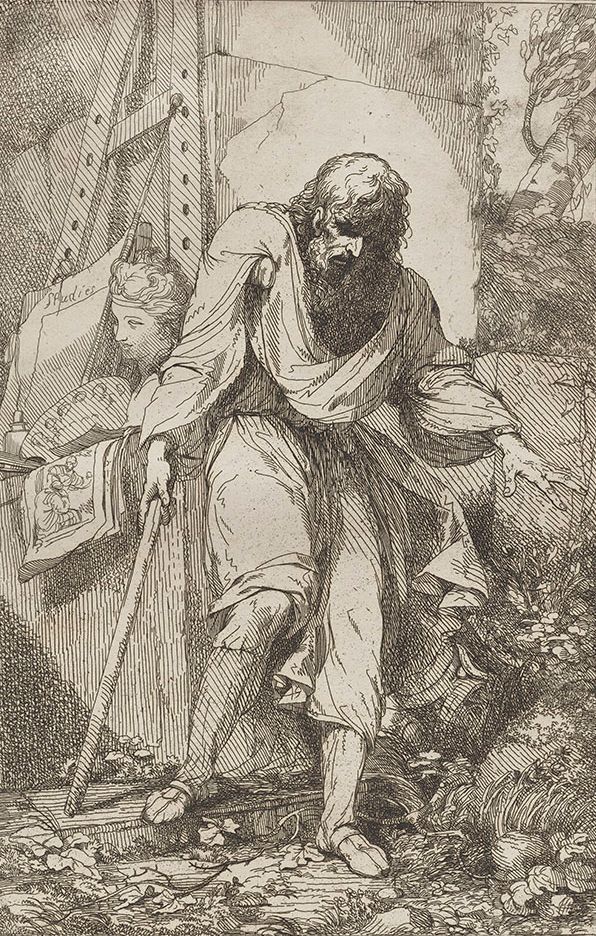This characteristic drawing was made by John Hamilton Mortimer in relation to the etched portrait he published of Gérard de Lairesse for part of a volume of fifteen etchings dedicated to Sir Joshua Reynolds printed in 1778. This drawing, which is orientated in the same direction as the etching, is unlikely to have been preparatory, but was probably made as part of a group of sheets Mortimer prepared for the young collector Sir George Beaumont. As Owen and Blaney Brown note in their extensive biography of Beaumont ‘the drawings, formerly kept in an album, are fine and characteristic examples of Mortimer’s sharp, sinewy manner in pen and ink. They include two remarkably portentous and significant works, companion portraits of a capricious and emotive character, both of artists – the one the young Salvator Rosa and the other the aged Gérard de Lairesse. They were among the first European representations of artists of earlier times and their interest for Beaumont must have been partly art historical.’[1]
Mortimer’s decision to pair imagined portraits of Rosa and Lairesse has been interpreted as subtle criticism of Sir Joshua Reynolds and his approach to teaching art at the Royal Academy. Gérard de Lairesse was a Dutch painter and art theorist, he is best remembered for his treatises on painting and drawing, Grondiegginge Ter Teekenkonst (1701) and Groot Schilderboek (1707). These texts were published in a single English text, The Art of Painting, in 1738 and re-issued in 1778, the year of publication of Mortimer’s etchings dedicated to Reynolds. Lairesse had congenital syphilis, which caused him to go blind in around 1690, he therefore turned to writing only after he had lost his ability to practice as a painter. Mortimer’s drawing clearly shows the blind Lairesse, leaning on his crutch, feeling his way amidst a barren landscape, away from the apparatus of his trade (palette, brushes, folio of drawings inscribed ‘studies after nature’ and easel). This depiction contrasts strongly with Mortimer’s evocation of the vigorous Salvator Rosa, dressed as a banditto and seated reading with his left hand clutched to his heart. The implicit contrast is between the anti-academic with the academic, the romantic with the classic, the painter of feeling and the theorist is clear. Later commentators have suggested that Mortimer can be identified as the man of feeling, in contrast to the great theorist Reynolds, whose first Seven Discourses were also published in 1778.[2]

John Hamilton Mortimer
Salvator Rosa
Black ink on off-white antique laid paper
10 15/16 x 8 ⅛ inches; 278 x 207 mm
Signed: black ink, on book: JH Mortimer/1776
1776
Harvard Art Museums/Fogg Museum, Alvin Whitley Fund
Mortimer’s drawings of Lairesse and Rosa were included in the album of drawings he sold, or possibly gave, to the young Sir George Beaumont, the drawing of Rosa is now in the collection of the Harvard Art Museums. Both drawings differ from the finished etchings. Mortimer’s treatment of Lairesse shows a difference in the treatment of the foreground and still life, in the etching Mortimer includes a roll of prints of Banditti on the plinth and inscribes the portfolio simply ‘Studies’. Benedict Nicholson’s identification of this drawing, and its pendant, as two of the first known works in European art of an artist making portraits of other artists of an earlier age, positions this sheet as the progenitor of an important European Romantic trope.



